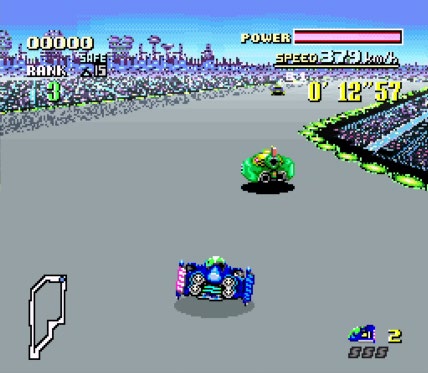Watch the video version of this essay here!
Speed is an aspect of a game that requires a lot of careful planning. Too fast and you overwhelm the player, not fast enough, and the game is either boring, or its physics feels too weighty. “Fast games” (like Star Wars Episode 1 Racer, Halo 2, and SSX 3) have everything from good presentation to tight controls communicating an extreme sense of speed.
Despite being from about a decade before the oldest game mentioned above, F-Zero is what I would call a fast game. Everything from the visual and auditory feedback to the controls exudes a sense of speed only present in the best racing games. Since it is an arcade racer dedicated to an air of future-cool, it’s vital that the game’s design and mechanics pull off the speed correctly. Despite being made at the very start of the 16-bit era of console gaming, F-Zero seems to take this challenge on in strides.

Things like jumps, barriers, and other drivers on the track add to the sense of speed and risk. You’re constantly reminded that you could crash and ruin your run at literally every moment. In addition, randomized traffic on the track keeps each run from being a memorized set of button presses for the best time, requiring the player to think on their feet in this intense blur of color and sound.
The game keeps the pressure high by having two distinct loss states to worry about, both are oft in direct contradiction. In my opinion, the easiest way to lose is to “Crash Out”. You have an energy bar to worry about, essentially the vehicle’s health, and once it gets to 0, that’s it; your race is over. You deplete this bar in various ways: bumping into the side barriers, running over marked ground, and running into other vehicles. This system is in place to punish the player for not being careful. Going too fast into a turn or hitting other racers can cause you to get very quickly stuck into a bouncing loop, and it will invariably be your fault. Using the brake on sharp turns and precise movements are not just advantageous in this game; they are required to be able to even finish the race.
The other, and often painfully complimentary loss state is “Rank Out”. The player is given a “safe rank” each lap to stay in until the next lap. Failure to do so or even reaching too far outside this safe ranking will result in an immediate loss and an early end to your run. This punishes the player for being too careful and not taking enough calculated risks. Like precision in control to avoid a fatal crash, taking advantage of risky shortcuts, making turns as tight as possible, and keeping your speed up are all imperative to your success in the F-Zero Grand Prix.



